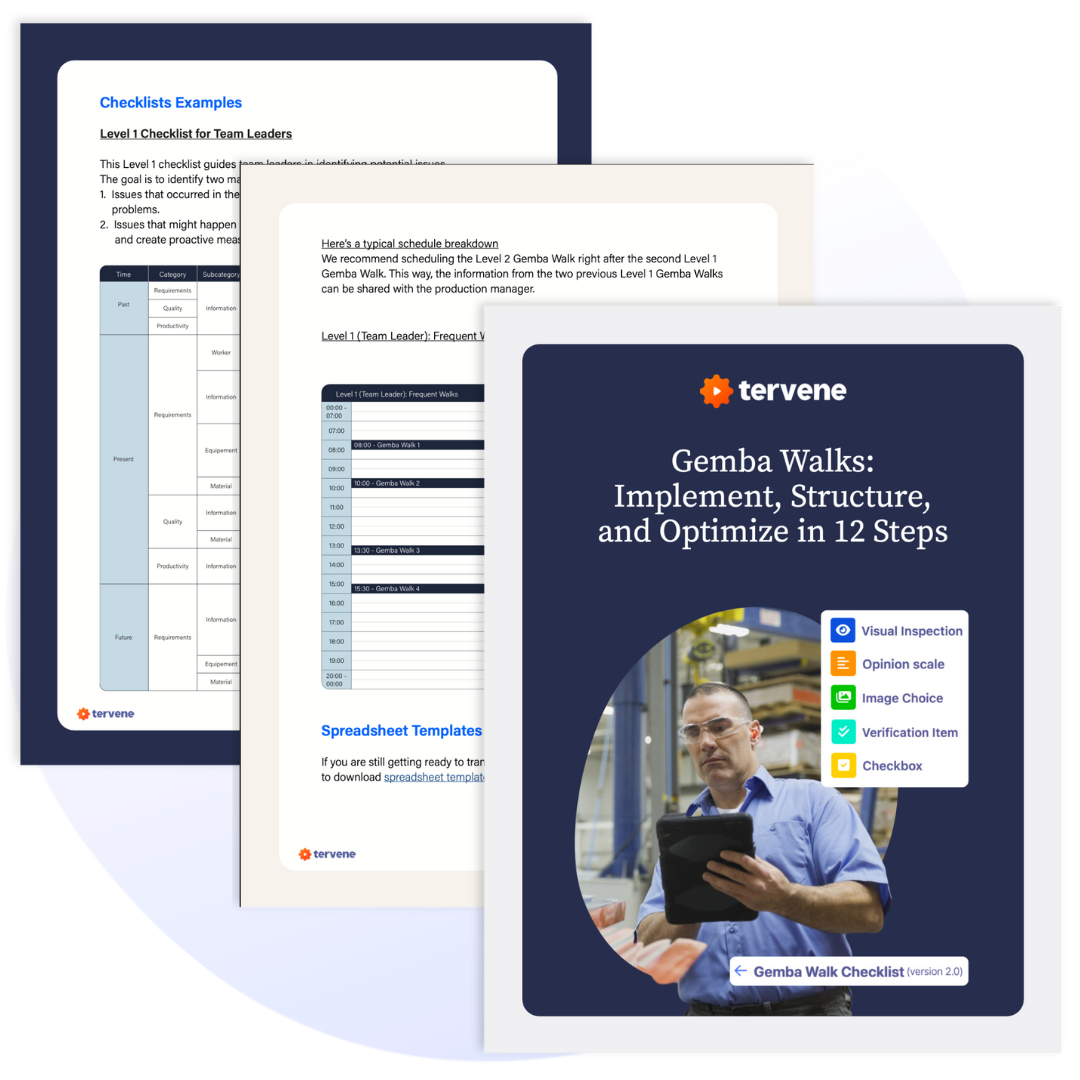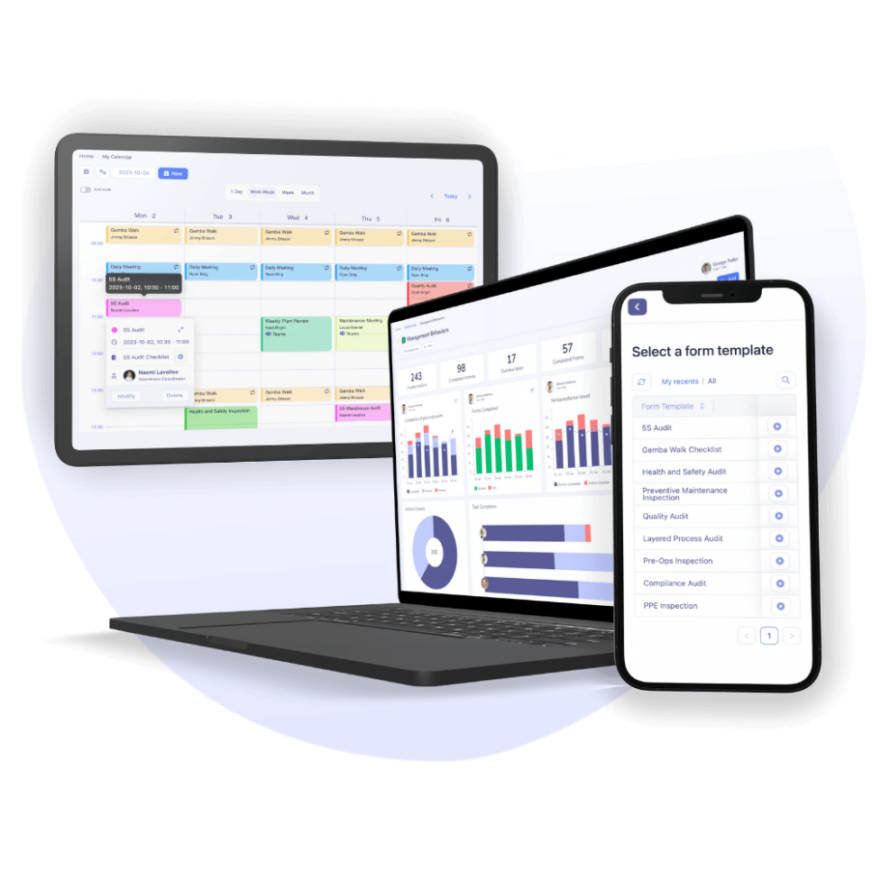A Gemba Walk is an operational control practice aiming to systematically validate standards, identify issues proactively, and generate improvement opportunities. A Gemba Walk structure ensures all management levels walk in the workplace. It involves going to the work area with a checklist, observing operations, engaging with employees, and asking questions.
Using the right tool will help supervisors and team leaders adhere to an efficient routine. It also aligns the operational control with the organization’s strategic objectives.

Gemba Walks: 12 Steps, Checklists & Templates
Gemba Walks contribute to:
Alignment: Align solutions with the organization’s strategic objectives.
Validation: Verify standards, identify issues, and document deviations.
Problem-solving: Proactively detect and solve problems.
Improvement: Identify optimization opportunities from recurring friction points.
Coaching: Train your team with up-to-date data.
What is a Gemba Walk App?
A Gemba Walk App is a digital tool designed for conducting efficient Gemba Walks in the workplace. Mainly used on smartphones and tablets, its purpose is to streamline tasks by providing checklists, questions, and checkpoints to guide users through the Gemba Walk process. It allows teams to track and document their observations easily. Organizations can enhance their operational efficiency, improve problem-solving, and foster a culture of continuous improvement by facilitating real-time data collection and analysis.

What are the 6 Gemba Walk App Essential Features?
1. Custom Checklists and Templates
A top-tier Gemba Walk application helps managers generate and adapt checklists to uncover improvement opportunities and address issues that might impact operations. These customizable lists and templates contain various questions associated with categories like Health and safety, Productivity, and Quality.
The app should offer multiple mandatory or optional questions (checkboxes, image choices, verification items, opinion scales, values, etc.), checkpoints, scheduling, and version control options. Moreover, the app should enable different departments and management levels to tailor each Gemba Walk to their objectives.
Essential features: Checklists, Various Question Types, Version Control Options, and Mandatory Questions.

2. Gemba Walk Schedules
Gemba Walk apps standardize schedules and enhance efficiency. Their users set different walk frequencies and reminders for all management levels:
- For team leaders, it could be daily.
- For supervisors, it could be weekly.
- For upper management, it could be bi-monthly.
Gemba Walk schedules are part of a successful Leader Standard Work program. The idea is to assign fixed routines to team members and promote accountability.
Essential features: Schedules, Reminders, and Notifications.

3. Thorough Documentation of Issues and Opportunities
An all-encompassing Gemba Walk solution facilitates meticulous documentation from the Gemba (factory floor or any location where value-generating tasks occur). For example, a team leader can effectively capture and categorize an issue or deviation using various mediums, like photos, videos, and notes.
Equally important is the accessibility of this documented information. Supervisors and team leaders take more effective action when accessing a complete context and history (what, who, when, where, why, and how the problem occurred).
Essential features: Custom Fields for Categorization, Photos, and Notes.

4. Seamless Problem-Solving Ecosystem
Streamlined Problem-Solving and Escalation Mechanisms
Well-built Gemba Walk apps go beyond issue identification; they seamlessly integrate concerns into a problem-solving ecosystem. For example, a team leader can quickly pass on a situation to senior management so that the people involved can find solutions and promote continuous improvement.
Efficient Task Management and Follow-Ups
Task management and follow-ups are central to an effective Gemba Walk app. It enables managers to assign tasks, subtasks, and corrective actions with due dates without interrupting the walk.
Cross-Functional Collaboration
Gemba Walk applications effortlessly foster cross-functional collaboration by bridging departments and management levels. They actively designate users to solve problems alongside support teams and promote task delegation to cross-functional groups (safety, quality, maintenance, engineering, continuous improvement, etc.). This approach extends to support team managers to ensure comprehensive, efficient solutions emerge through cohesive teamwork.
Essential features: Task Management, Corrective Actions, Notifications, and Escalation Process.
5. Managing Improvement Opportunities
Gemba Walks serve as a wellspring of improvement opportunities and should be compatible with continuous improvement tools. This integration reduces transcription needs, streamlines project prioritization (with Kanban boards), and equips managers with the necessary context to execute improvements. Effective Gemba Walk apps allow organizations to generate visuals and action plans to apply the PDCA method (Plan-Do-Check-Act).
Essential features: Action Plans, Kanban Boards, Prioritization.
6. Gemba Walk Reports and Dashboards
Accessible Gemba Walk reports, and performance indicators are irreplaceable tools for managers. They provide a record of results while allowing the review of answers, notes, findings, and follow-up actions. Thanks to better visibility offered by apps, managers can assess the quality of Gemba Walks conducted by their teams anywhere, anytime. Additionally, Gemba Walk dashboards provide a quick overview of the adherence to the program and its effectiveness.
Essential features: Gemba Walk Reports, Gemba Walk Dashboards.
Bonus. User-friendly Interface and Multi-device Accessibility
A user-friendly interface often tips the balance in favor of one Gemba Walk application over another. Indeed, supervisors, managers, and team leaders should be able to navigate the tool effortlessly. Its compatibility with smartphones, tablets, and computers, regardless of their operating system, is also a key factor. This multi-device accessibility enables users to carry out Gemba Walks, access reports, and manage improvement opportunities from any preferred device or location.

Digital Gemba Walks VS. Paper-based Gemba Walks
Managers who carry out Gemba Walks use the tools available, whether paper and pen or spreadsheets. These traditional methods could slow down data collection and limit the visibility of information due to transcription delays. A digital floor tour solution capable of the 6 Gemba Walk App Essential Features standardizes operational control, increases the visibility of results, and eliminates manual data entry. Put, digitizing information promotes best practices.
Related article: Benefits of Digital Gemba Walks
Tervene’s Gemba Walk App
Discover a Gemba Walk app that aligns with your organization’s objectives and significantly enhances your continuous improvement initiatives by:
- Building standard and custom Gemba Walk checklists
- Scheduling Gemba Walks for each process, team, or area
- Allowing managers to identify issues proactively
- Helping with thorough documentation
- Addressing issues quickly and efficiently
- Transforming recurring problems into improvement opportunities
- Communicating concerns with the group without delay
- Tracking issues, action plans, and performance



























